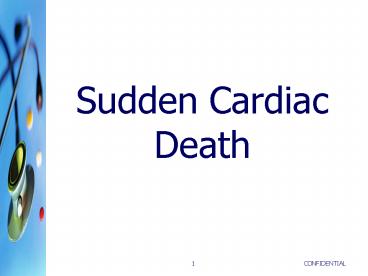Sudden Cardiac Death - PowerPoint PPT Presentation
1 / 15
Title:
Sudden Cardiac Death
Description:
Myocardial infarction (aka heart attack) refers to the death of heart tissue due ... Chronic elevation of myocardial stress (due to pressure overload) causes cardiac ... – PowerPoint PPT presentation
Number of Views:1407
Avg rating:3.0/5.0
Title: Sudden Cardiac Death
1
Sudden Cardiac Death
2
Pathophysiology
- Clinical scenario where a person experiences a
loss of consciousness, usually due to a
ventricular tachyarrhythmia or severe bradycardia
and asystole when a rhythm is not restored,
results in death. - Time and mode of death are unexpected.
- Occurs within minutes of onset of symptoms.
3
SCD vs. Heart Attack
- Myocardial infarction (aka heart attack) refers
to the death of heart tissue due to the lack of
blood supply. - Heart attack COULD lead to cardiac arrest and
SCD. - Cardiac arrest leads to SCD.
4
Prevalence
- Who is at risk?
- Those who have had previous myocardial
infarctions. - Individuals with CAD.
- Considered a rare event but due to recent deaths
in young athletes, sudden cardiac death (SCD) is
drawing more attention in research. - Very mysterious condition because there is no
documented cause.
5
Speculated Causes of SCD
- Most Common Factors
- Left ventricular hypertrophy
- Increased cardiac mass
- Aortic ruptures
- Myocarditis
- Aortic stenosis
- Rare Factors
- Dilated cardiomyopathy
- Atherosclerotic CAD
- Mitral Value prolapse
- Isolated arrhythmias
- Commotio cordis (Trauma to the chest wall common
in young athletes)
6
Left Ventricular Hypertrophy
- Most commonly found factor in people that have
died from SCD - Chronic elevation of myocardial stress (due to
pressure overload) causes cardiac muscle to
hypertrophy - Leads to increase in myocardial thickness and
impairment of systolic function and finally left
ventricular failure
7
Left Ventricular Hypertrophy
- Causes
- Hypertension
- Valvular heart disease
- Coronary Heart Disease
- There are no known symptoms of left ventricular
hypertrophy. - Strategies for controlling LVH
- Keep blood pressure low
- Manage weight
- Monitor blood glucose
8
Signs SymptomsRelated to SCD
- Known left ventricular hypertrophy
- Syncope
- Non-sustained ventricular tachycardia
- Ventricular fibrillation
- Low ejection fraction (
9
Prevention Management
- Treat and monitor diseases/conditions that can
contribute to heart problems. - Exercise
- Diet and weight control
- No smoking
- Control heart rhythms
- Implantable cardioverter defibrillators sense
when the heart is beating too fast and send a
jolt of energy directly to the heart and restored
normal rhythm
10
Treatment
- Direct treatment of SCD is unknown
- Typical treatment is based on existing conditions
- Pacemakers
- Automatic external defibrillator
- Medications for CAD
11
Medications
- Taken to control heart rhythms or to treat other
conditions that contribute to heart disease - ACE inhibitors
- Beta-blockers
- Calcium channel blockers
12
Effect on Exercise
- Death
13
Effect of Exercise
- Acute, especially due vigorous exercise DEATH
- Chronic exercise decreases risk of CAD, which
should decrease risk of SCD. - Recommendations
- Aerobic vs. Resistance Exercise
- Which is safer if you are at risk?
14
Precautions
- Individuals who should avoid vigorous exercise
- Diagnosed with CAD
- Positive family history of SCD
- Diagnosed left ventricular hypertrophy
15
Recommendations
- Limited due to lack of knowledge of event
- Precautions should be taken when signs symptoms
are evident. - Diagnostic tests for heart disease
- ECG, sonogram, ultrasound
- Additional padding in contact sports to cover
chest walls - AEDs should be present at all sporting events or
in all exercise facilities. - Use of AED in combination with CPR has a high
survival rate if used within 3 minutes of event.































